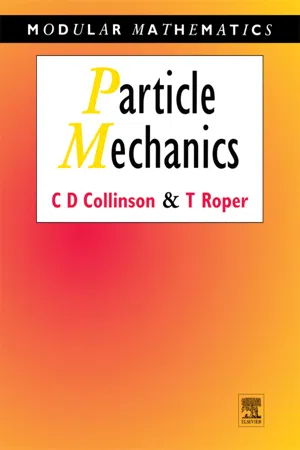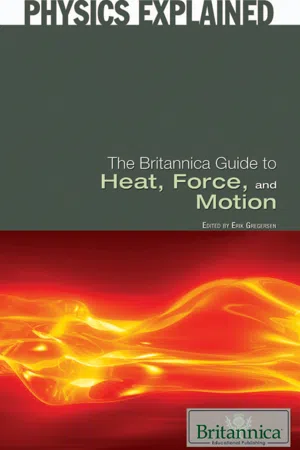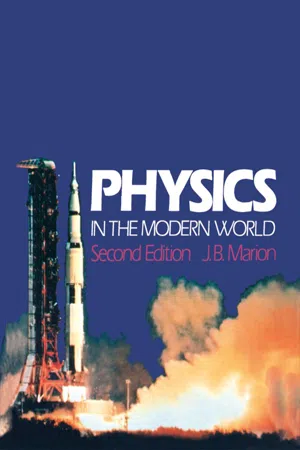Mathematics
Motion in Space
Motion in space refers to the movement of an object in three-dimensional space. It is described using parameters such as position, velocity, and acceleration. In mathematics, this concept is often studied using vectors and parametric equations to analyze the path and behavior of objects moving through space.
Written by Perlego with AI-assistance
Related key terms
5 Key excerpts on "Motion in Space"
- eBook - ePub
- Hiqmet Kamberaj(Author)
- 2021(Publication Date)
- De Gruyter(Publisher)
4 Two- and three-dimensional motionIn this chapter, we will discuss the kinematics of a particle moving in two and three dimensions. Utilizing two- and three-dimensional motion, we will be able to examine a variety of movements, starting with the motion of satellites in orbit to the flow of electrons in a uniform electric field. We will begin studying in more detail the vector nature of displacement, velocity, and acceleration. Similar to one-dimensional motion, we will also derive the kinematic equations for three-dimensional motion from these three quantities’ fundamental definitions. Then the projectile motion and uniform circular motion will be described in detail as particular cases of the movements in two dimensions.4.1 The displacement, velocity, and acceleration vectors
When we discussed the one-dimensional motion (see Chapter 3 ), we mentioned that the movement of an object along a straight line is thoroughly described in terms of its position as a function of time,x ( t ). For the two-dimensional motion, we will extend this idea to the movement in thex yplane.As a start, we describe a particle’s position by the position vector r pointing from the origin of some coordinate system to the particle located in thex yplane, as shown in Fig. 4.1 . At timet ithe particle is at point P, and at some later timet fit is at the position Q. The path from P to Q generally is not a straight line. As the particle moves from P to Q in the time intervalΔ t =, its position vector changes fromt f−t ir itor f.Definition 4.1 (Displacement vector).
The displacement is a vector, and the displacement of the particle is the difference between its final position and its initial position. We now formally define the displacement vector for the particle as the difference between its final position vector and its initial position vector:(4.1)Δ r =r f−r i.The direction ofΔ ris indicated in Fig. 4.1 from P to Q. Note that the magnitude ofΔ r - eBook - ePub
- Chris Collinson, Tom Roper(Authors)
- 1995(Publication Date)
- Butterworth-Heinemann(Publisher)
4Motion in Space
Many of the ideas discussed in Chapter 2 are generalized to the motion of a particle moving in space. A vectorial approach is used throughout, coordinates, when used, being adapted to the problem being discussed. The importance of the choice of frame of reference used to describe the motion of a given particle is stressed and the role played by Newton’s first law of motion in the choice of the frame of reference is discussed. Three different types of conservation laws are derived. These are important in that they provide first integrals of the equation of motion which can be written down without the need for carrying out actual integrations. Newton’s third law of motion is stated in both a weak and strong form. Much of this Chapter is concerned with development of the theory and the opportunity for tackling exercises is therefore somewhat restricted.4.1 Kinematics of a Particle Moving in Space
Consider a particle moving in space. The definitions and results which we are about to discuss are generalizations of those discussed in Section 2.1 for a particle P moving on a straight line. In Section 2.1 the position of P was specified, relative to a given origin O lying on the line of motion, by a directed number x , the displacement of P relative to O. You will have noticed the fact that if the line of motion is chosen as the x-axis of a cartesian coordinate system with origin O , then the displacement of P relative to O is just the × coordinate of P. An obvious generalization for a particle P moving in space would be to specify the position of P relative to a given origin by the cartesian coordinates (x, y, z) of P relative to a given set of axes passing through O. In order to simplify later calculations we confine attention here to right handed rectangular cartesian coordinates for which the axes are mutually perpendicular and orientated with O z in the direction of the thumb of the right hand when the curled fingers of that hand are scooped from O x to O y, as in Fig 4.1 . The axes are said to form a frame of reference or frame - eBook - ePub
- Michael M. Mansfield, Colm O'Sullivan(Authors)
- 2020(Publication Date)
- Wiley(Publisher)
4 Motion in two and three dimensionsAIMS
- to show how, in two and three dimensions, physical quantities can be represented by mathematical entities called vectors
- to rewrite the laws of dynamics in vector form
- to study how the laws of dynamics may be applied to bodies which are constrained to move on specific paths in two and three dimensions
- to describe how the effects of friction may be included in the analysis of dynamical problems
- to study the motion of bodies which are moving on circular paths
4.1 Vector physical quantities
The material universe is a three‐dimensional world. In our investigation of the laws of motion in Chapter 3 , however, we considered only one‐dimensional motion, that is situations in which a body moves on a straight line and in which all forces applied to the body are directed along this line of motion. If a force is applied to a body in a direction other than the direction of motion the body will no longer continue to move along this line. In general, the body will travel on some path in three‐dimensional space, the detail of the trajectory depending on the magnitude and direction of the applied force at every instant. Equation (3.3) as it stands is not sufficiently general to deal with such situations, for example the motion of a pendulum bob (Figure 4.1 ) or the motion of a planet around the Sun (Figure 4.2 ). Newton's second law needs to be generalised from the simple one‐dimensional form discussed in Chapter 3 .A pendulum comprising a mass attached to the end of a string; the mass can move on a path such that the distance from the fixed end of the string remains constant.Figure 4.1A similar problem arises if two or more forces act on a body simultaneously, for example when a number of tugs are manoeuvring a large ship (Figure 4.3 - eBook - ePub
- Britannica Educational Publishing, Erik Gregersen(Authors)
- 2010(Publication Date)
- Britannica Educational Publishing(Publisher)
Resonances are not uncommon in the world of familiar experience. For example, cars often rattle at certain engine speeds, and windows sometimes rattle when an airplane flies by. Resonance is particularly important in music. For example, the sound box of a violin does its job well if it has a natural frequency of oscillation that responds resonantly to each musical note. Very strong resonances to certain notes—called “wolf notes” by musicians—occur in cheap violins and are much to be avoided. Sometimes, a glass may be broken by a singer as a result of its resonant response to a particular musical note.MOTION OF A PARTICLE IN TWO OR MORE DIMENSIONS
More complex problems in mechanics involve a particle moving in two or more dimensions. Such problems include those of the pendulum and the circular orbit.PROJECTILE MOTIONGalileo pointed out with some detectable pride that none before him had realized that the curved path followed by a missile or projectile is a parabola. He had arrived at his conclusion by realizing that a body undergoing ballistic motion executes, quite independently, the motion of a freely falling body in the vertical direction and inertial motion in the horizontal direction. These considerations, and terms such as ballistic and projectile, apply to a body that, once launched, is acted upon by no force other than Earth’s gravity.Projectile motion may be thought of as an example of Motion in Space—that is to say, of three-dimensional motion rather than motion along a line, or one-dimensional motion. In a suitably defined system of Cartesian coordinates, the position of the projectile at any instant may be specified by giving the values of its three coordinates, x (t ), y (t ), and z (t ). By generally accepted convention, z (t ) is used to describe the vertical direction. To a very good approximation, the motion is confined to a single vertical plane, so that for any single projectile it is possible to choose a coordinate system such that the motion is two-dimensional [say, x (t ) and z (t )] rather than three-dimensional [x (t ), y (t ), and z (t - eBook - ePub
- Jerry Marion(Author)
- 2012(Publication Date)
- Academic Press(Publisher)
2MOTION
Publisher Summary
This chapter presents an overview of motion. It describes the motion of automobiles and planets. Acceleration is the change in speed per unit time. The speed of an object at any instant is equal to the slope of the distance–time graph. The acceleration of an object is equal to the slope of the speed–time graph. The chapter illustrates the connection between speed and acceleration. It further illustrates equations for the analysis of motion. When an object is dropped, the gravitational attraction of the earth causes the object to fall with continually increasing speed—the object is accelerated by gravity. The chapter discusses the vertical motion of an object moving freely near the surface of the earth. The vertical and horizontal motions do not affect one another. The chapter explains motion in two dimensions and discusses parabolic motion of an object.We live in a restless Universe. Everything around us—from the atoms that make up all matter to automobiles and aircraft to the distant galaxies of stars in space—undergoes motion. Every physical process involves motion of some sort. Because motion is such an important feature of every physical process, it is the logical subject with which to begin our detailed study of physical phenomena. The ideas developed here are used throughout this survey—in describing the motion of automobiles and planets, in discussing electric current, and in studying the behavior of atoms and nuclear particles. Motion is at the heart of every physical process.2-1 AVERAGE SPEED
Distance and Time
If an object is in one position at a certain time and is in a different position at a later time, we know that movement has occurred. How can we describe the details of movement in a meaningful way? When we take a trip by automobile and note the behavior of the speedometer, we see that we rarely travel very long at constant speed. For one reason or another, it is frequently necessary to slow down or speed up. By the time the trip is completed, we have traveled at many different speeds. But there is still one speed—the average
Index pages curate the most relevant extracts from our library of academic textbooks. They’ve been created using an in-house natural language model (NLM), each adding context and meaning to key research topics.




